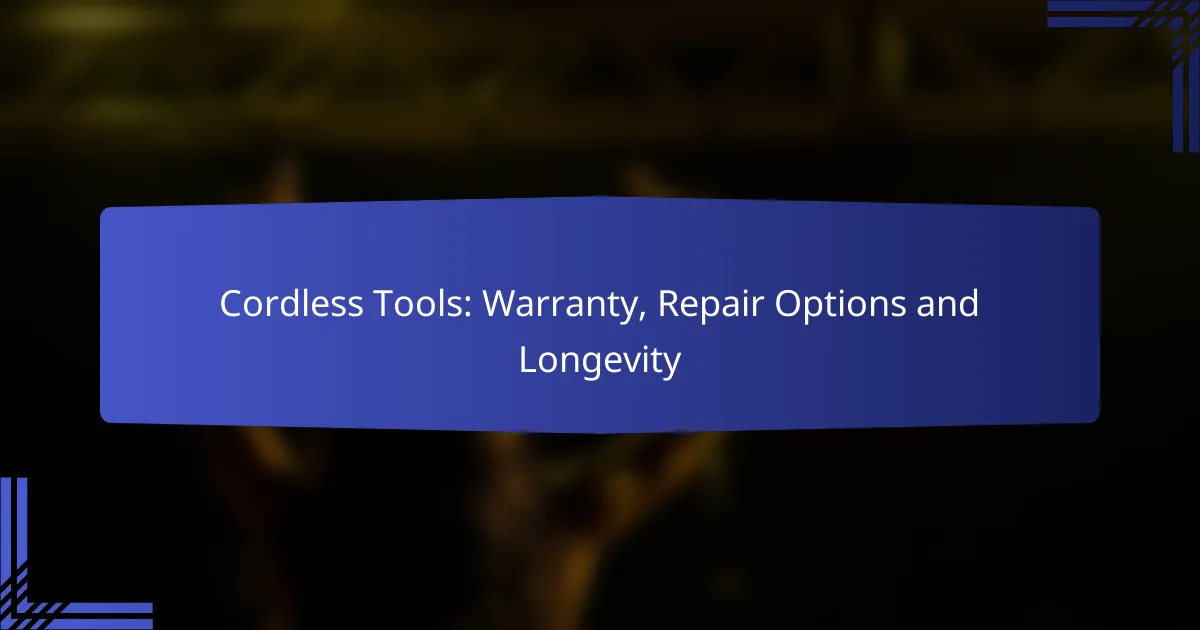When investing in cordless tools, it’s essential to understand the warranty options available, including manufacturer and extended warranties, to protect against defects. Repairing these tools can often be manageable with basic troubleshooting or professional assistance, ensuring they remain functional. With proper maintenance, cordless tools can last between five to ten years, making them a valuable investment for both professionals and DIY enthusiasts.

What warranty options are available for cordless tools?
Warranty options for cordless tools typically include manufacturer warranties, extended warranties, and retailer-specific warranties. Understanding these options can help you choose the right tool and ensure protection against defects and failures.
Manufacturer warranties
Manufacturer warranties are provided directly by the tool’s producer and usually cover defects in materials and workmanship for a specified period, often ranging from one to five years. These warranties may also include provisions for repair or replacement at no cost to the consumer.
It’s essential to read the warranty terms carefully, as some manufacturers may require proof of purchase or specific maintenance practices to validate the warranty. Always register your tool online if required to ensure coverage.
Extended warranties
Extended warranties are additional coverage options that can be purchased to extend the protection period beyond the manufacturer’s warranty. These warranties can vary significantly in terms of cost and coverage, often lasting from one to several years.
When considering an extended warranty, evaluate the cost against potential repair expenses. Sometimes, it may be more economical to save for repairs rather than invest in an extended warranty, especially if the tool is known for its durability.
Retailer-specific warranties
Retailer-specific warranties are offered by the store where the cordless tool was purchased and may provide additional protection or benefits beyond the manufacturer’s warranty. These warranties can vary widely in terms of duration and coverage details.
Check with the retailer about their specific warranty policies, as some may offer satisfaction guarantees or hassle-free returns within a certain timeframe. This can be particularly useful if you encounter issues shortly after purchase.

How to repair cordless tools?
Repairing cordless tools can often be straightforward, depending on the issue. Basic troubleshooting, replacement of parts, or seeking professional help are common approaches to restore functionality.
DIY repair options
Many cordless tool issues can be resolved with DIY repairs. Start by checking the battery; often, a simple recharge or replacement can fix performance problems. For minor repairs, such as replacing brushes or switches, consult the user manual for guidance.
Gather basic tools like screwdrivers, pliers, and a multimeter for electrical diagnostics. Online tutorials and forums can provide step-by-step instructions for specific models, making it easier to tackle common issues.
Professional repair services
If DIY repairs are beyond your skill level or the problem persists, consider professional repair services. These services can diagnose and fix complex issues, often with a quicker turnaround than you might expect.
Costs for professional repairs can vary widely, generally ranging from $50 to $150, depending on the extent of the damage and the tool’s brand. Always check reviews and ask for estimates before committing to a service.
Manufacturer repair programs
Many manufacturers offer repair programs that can be a reliable option for fixing cordless tools. These programs typically ensure that repairs are done using original parts, which can extend the tool’s lifespan.
Check the manufacturer’s website for details on warranty coverage and repair options. Some brands may provide free repairs within the warranty period, while others might charge a fee. Make sure to keep your purchase receipt, as it may be required for warranty claims.

What is the longevity of cordless tools?
The longevity of cordless tools typically ranges from five to ten years, depending on usage, maintenance, and brand quality. Regular care and proper usage can significantly extend their lifespan, making them a worthwhile investment for both professionals and DIY enthusiasts.
Average lifespan of popular brands
Different brands of cordless tools exhibit varying lifespans based on their construction and technology. For instance, brands like DeWalt and Milwaukee often last around seven to ten years, while others like Ryobi may average closer to five to eight years. Users should consider brand reputation and reviews when selecting tools for durability.
Factors affecting longevity
Several factors influence the longevity of cordless tools, including frequency of use, type of tasks performed, and maintenance practices. Tools used for heavy-duty applications may wear out faster than those used for lighter tasks. Additionally, regular cleaning, battery care, and proper storage can enhance the lifespan of these tools.
Environmental conditions also play a role; exposure to extreme temperatures or moisture can degrade components over time. Users should avoid leaving tools in harsh conditions and ensure batteries are charged according to manufacturer guidelines to maximize their lifespan.

What are the best practices for maintaining cordless tools?
To ensure the longevity and optimal performance of cordless tools, regular maintenance and proper care are essential. This includes routine cleaning, battery management, and following manufacturer guidelines for usage and storage.
Regular cleaning and maintenance
Keeping cordless tools clean is vital for their performance and lifespan. After each use, wipe down the tool to remove dust, debris, and moisture that can cause corrosion or mechanical issues.
Additionally, check for any loose screws or parts and tighten them as necessary. Regularly inspect the tool for wear and tear, and replace any damaged components promptly to avoid further damage.
Battery care tips
Proper battery care significantly influences the performance and longevity of cordless tools. Always store batteries in a cool, dry place, ideally between 20°C and 25°C (68°F to 77°F), to prevent overheating and degradation.
Charge batteries according to the manufacturer’s instructions and avoid letting them fully discharge frequently, as this can shorten their lifespan. For optimal performance, consider using the battery until it reaches around 20% before recharging.

How do warranty claims work for cordless tools?
Warranty claims for cordless tools typically involve submitting a request to the manufacturer or retailer, detailing the issue and providing proof of purchase. Most warranties cover defects in materials and workmanship for a specified period, often ranging from one to three years, depending on the brand and model.
Claim process overview
The claim process generally starts with reviewing the warranty terms to ensure the issue is covered. Next, gather necessary documentation, such as the original receipt and any relevant photos of the tool’s condition. Submit the claim through the manufacturer’s website, customer service line, or authorized retailer, following their specific instructions.
After submission, the manufacturer will evaluate the claim, which may involve inspecting the tool. If approved, they will either repair or replace the tool, often at no cost to you, depending on the warranty terms.
Common reasons for claim denial
Claims can be denied for several reasons, including lack of proof of purchase or if the warranty period has expired. Damage caused by misuse, neglect, or unauthorized repairs typically voids the warranty as well.
Additionally, modifications made to the tool or failure to follow the manufacturer’s usage guidelines can lead to denial. It’s crucial to read the warranty carefully and adhere to all specified conditions to avoid pitfalls.

What are the compatibility options for cordless tool batteries?
Compatibility for cordless tool batteries primarily depends on the brand and model of the tools. Most manufacturers design their batteries to work exclusively with their own tools, which can limit cross-compatibility.
Brand-specific compatibility
Brand-specific compatibility means that batteries are typically designed to fit only tools from the same manufacturer. For example, a battery from Brand A may not work with tools from Brand B, even if they appear similar. This design choice ensures optimal performance and safety.
When purchasing new batteries, always check the manufacturer’s specifications. Some brands may offer a range of tools that share battery compatibility, allowing you to use the same battery across multiple devices. This can save money and reduce waste.
To avoid pitfalls, look for tools that explicitly state battery compatibility in their descriptions. If you’re considering third-party batteries, ensure they are certified for use with your specific brand to avoid potential damage or voiding warranties.
